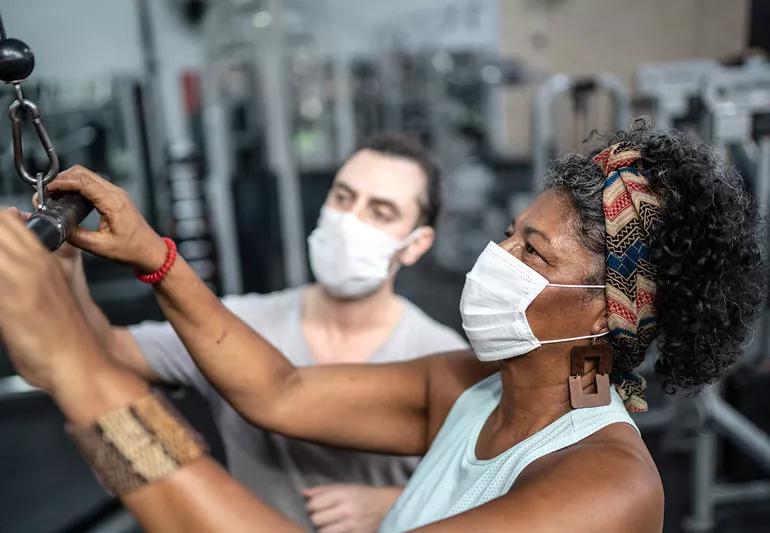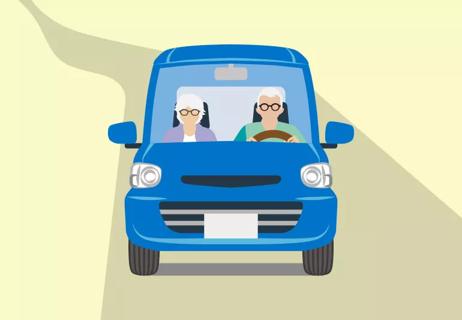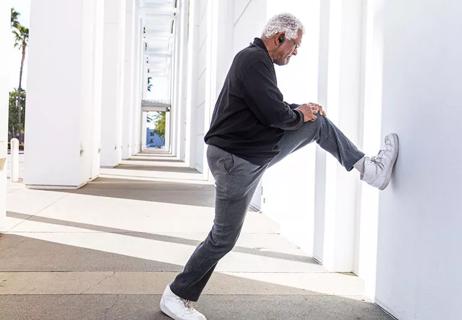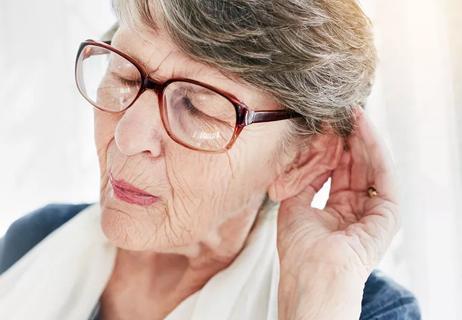Learn how simple movements can preserve your health — and lessen your risk for falls

According to the Centers for Disease Control and Prevention (CDC), an older adult (age 65+) suffers a fall just about every second of every day in this country. It’s also estimated that about 36 million older adults fall each year, resulting in more than 32,000 deaths.
Advertisement
Cleveland Clinic is a non-profit academic medical center. Advertising on our site helps support our mission. We do not endorse non-Cleveland Clinic products or services. Policy
These statistics are alarming in a normal year. During the pandemic, many feared that the number of falls would increase dramatically given seniors weren’t able to get out and walk or do the things that help preserve their mobility. Because of this, many healthcare systems and providers developed initiatives to encourage seniors to stay active at home.
Many seniors might not feel comfortable re-entering society with COVID-19 and its variants floating around. And as they sit at home, their muscles can become weaker — which can increase their risk for falls.
Physical therapist Amy Cassady says there are things that seniors can do to decrease their fall risks and keep their minds and bodies fit. Read on to find out why senior mobility is so important and to discover a few simple exercises that seniors can do at home.
When you can move and do the things you’re used to doing, you feel good. So, not only is mobility good for your body, but it’s also good for your mind and your self-esteem.
“Being active is good for your bones, your heart and emotional as well as social health. It’s also great for anxiety and depression management. Exercise not only benefits your muscle and bone health, but it also boosts your emotional well-being,” says Cassady.
Advertisement
When seniors don’t get enough physical activity in, Cassady says their chances of experiencing falls increase and they can become physically weaker. She says she’s seen the toll that the pandemic has taken on some of her patients. Not being able to get out and exercise has left many feeling winded or unsteady.
“I hear a lot of my patients, regardless of their abilities, saying they can’t tolerate as much activity. Now that the weather is warmer, they’re starting to get out and do yardwork and they get tired quickly. Running errands has become exhausting. They also mention imbalance, reduced strength, stiffness, pain and reduced flexibility.”
Cassady adds that with all of the sitting that people have done in the last year, many of her patients have mentioned that their hips, knees and backs have tightened up.
“I’m hearing about a lot of flexibility issues. Most of my patients have said that they feel stiff or sore. And with arthritic joints, they’re stiffer than they used to be.”
Despite the pandemic, a good number of Cassady’s patients continue to come in for physical therapy. Her team’s commitment to their safety has been very reassuring.
“I wear a face shield, a mask and gloves. We wipe down everything that someone uses — hand weights, parallel bars — we clean everything thoroughly. We have a lot of space so we’re not on top of each other and we’re still maintaining physical distance. We even have separate areas for checking people in and checking out. Initially, some people were uncertain about coming in, but we’re seeing less and less of that now. I think people are more confident and they’re more comfortable wearing masks during their sessions.”
If you’ve been putting physical therapy sessions off, now is the time to get started again. Healthcare providers like Cassady ensure that patients get the services they need in environments that are safe and sanitized. And even though mask mandates are being lifted across the country, Cassady says masks are still being worn along with other personal protective equipment in many healthcare settings.
Cassady says that adults 65 and over should aim for 150 minutes of moderate physical activity per week. You should also add muscle-strengthening activities at least two days a week. However, if you can’t do 150 minutes of moderate-intensity aerobic activity a week because of a chronic condition, you can start by doing five minutes of activity a few times a day and build from there.
The National Institute on Aging says four types of exercises can help improve seniors’ health and physical ability. They are:
Strength: Designed to strengthen your muscles, these exercises include activities like lifting weights, carrying groceries, gripping a tennis ball, lifting your body weight or using a resistance band.
Endurance: Endurance exercises help increase your breathing and heart rate so you can carry out daily tasks. Endurance activities include: Walking or jogging, dancing, climbing stairs and swimming. If your mobility is limited, you can even march in place or march while sitting.
Advertisement
Balance: Lower-body strengthening exercises can help improve balance and prevent falls. However, Cassady recommends adding balance-specific exercises to your routine as well. Tai Chi, standing on one foot, heel-to-toe walks and standing from a seated position are all great activities that promote balance.
Flexibility: These activities can help make it easier for you to bend down to tie your shoes or to look over your shoulders when needed. Flexibility exercises include stretching and yoga.
Cassady strongly advises exercising near stable surfaces. These surfaces can include walls, kitchen counters and steady dressers or tables. Should you start to feel unsteady, you can always use these surfaces to regain your balance. And pace yourself when you’re doing any activity. If you’re not confident about trying a new exercise, talk to your healthcare provider before jumping into a new routine. They might determine that it’s best to work with a physical therapist.
Here are some easy activities that you can do to build strength, flexibility, balance and endurance at home.
Stand in front of a wall. Put your arms out in front of you and make sure that your palms are flat against the wall. Take a step back and keep your feet shoulder-width apart. Pull your abs in and keep your shoulders back. You’re then going to draw yourself closer to the wall like you would if you were doing a push-up on the ground. Breathe in while you’re doing so and hold yourself in the bent arm position for a second. Then, push back out and exhale as you extend your arms. If you’re not very active, do five to start. As you get stronger, you can try doing 10 or 15 push-ups.
Advertisement
Stand with one foot in front of the other (toe to heel). Put your arms up and out to the sides to help maintain your balance. Pull your abs in and hold your shoulders back. Walk slowly, as if you were walking on a balance beam or tightrope, placing one foot in front of the other. If you’re not steady on your feet, you can do this next to the wall or a counter.
Use light weights (one to three pounds) or soup cans for this next activity. Take a weight in each hand and slowly bend or curl your forearms up to your chest. Then, slowly lower your arms. Repeat this exercise between five to 12 times depending on your activity level. You can do two sets of five to 10 if you feel up to it. Don’t forget to exhale as you curl your arms.
Use a sturdy chair that’s up against the wall, a stable bench or your sofa for this next one. It just involves you moving from a sit to a stand. Do this movement slowly. And if you’re a little wobbly, you can do this one with a walker, cane or help from a relative.
You don’t have to leave the neighborhood or even your yard to get a walk in. You can walk around your house during commercial breaks or you can walk up and down the driveway if it’s safe to do so, meaning there aren’t any fall risks. You can even march in place or do a seated march if you have a hard time standing.
Advertisement
By stretching, you can keep your body loose for daily activities. You always want to stretch when your muscles have been warmed up and after any endurance or strength exercises. Be sure to stretch your back, neck, legs, arms and even your ankles. Stretching before bed can also help you sleep better.
If you use a wheelchair, Cassady says you can exercise at home as well.
“There are seated workout routines. Wheelchair users can do shoulder shrugs, reaches and bicep curls if their shoulders are OK. They can also march in place while sitting, lift and straighten their knees and do ankle pumps. Some people might be able to do sit-to-stand exercises as well. That exercise can help them build enough leg strength to tolerate standing a little better.”
You might be eager to jump into a new routine especially if the pandemic has taken so much out of you. But Cassady encourages you to go slow and gradually build up your physical activity.
“Mild muscle fatigue may happen as you start an exercise program. You might do five or 10 minutes of standing exercises and feel worn out. Keep in mind that as you continue to exercise daily, you’re going to gradually build up your stamina. Try strengthening exercises two days a week. If you experience some soreness, spacing out strengthening sessions will allow the soreness to resolve over a couple of days. But you never want to exercise to the point of pain.”
Learn more about our editorial process.
Advertisement

Many chronic conditions can cause fatigue — but don’t overlook mental health concerns, iron level and hormones

Some planning, products and projects can help older adults stay in their homes safely longer

Loneliness is a key factor in worsening mental health among seniors

What to look for and how to handle signs of impaired driving

Leverage the synergy of simple adjustments

The signs might be subtle

What you can do about hearing and vision loss

Exercising and stretching your lower back, hamstrings, hips and quads can greatly improve your physical well-being

If you’re feeling short of breath, sleep can be tough — propping yourself up or sleeping on your side may help

If you fear the unknown or find yourself needing reassurance often, you may identify with this attachment style

If you’re looking to boost your gut health, it’s better to get fiber from whole foods